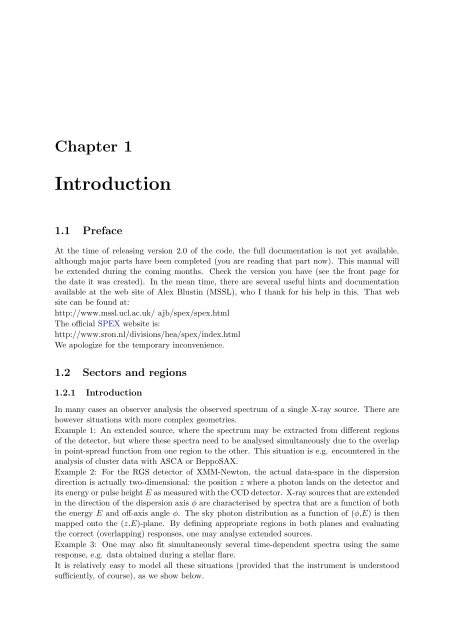SPEX Reference manual (PDF) - SRON
SPEX Reference manual (PDF) - SRON
SPEX Reference manual (PDF) - SRON
You also want an ePaper? Increase the reach of your titles
YUMPU automatically turns print PDFs into web optimized ePapers that Google loves.
Chapter 1<br />
Introduction<br />
1.1 Preface<br />
At the time of releasing version 2.0 of the code, the full documentation is not yet available,<br />
although major parts have been completed (you are reading that part now). This <strong>manual</strong> will<br />
be extended during the coming months. Check the version you have (see the front page for<br />
the date it was created). In the mean time, there are several useful hints and documentation<br />
available at the web site of Alex Blustin (MSSL), who I thank for his help in this. That web<br />
site can be found at:<br />
http://www.mssl.ucl.ac.uk/ ajb/spex/spex.html<br />
The official <strong>SPEX</strong> website is:<br />
http://www.sron.nl/divisions/hea/spex/index.html<br />
We apologize for the temporary inconvenience.<br />
1.2 Sectors and regions<br />
1.2.1 Introduction<br />
In many cases an observer analysis the observed spectrum of a single X-ray source. There are<br />
however situations with more complex geometries.<br />
Example 1: An extended source, where the spectrum may be extracted from different regions<br />
of the detector, but where these spectra need to be analysed simultaneously due to the overlap<br />
in point-spread function from one region to the other. This situation is e.g. encountered in the<br />
analysis of cluster data with ASCA or BeppoSAX.<br />
Example 2: For the RGS detector of XMM-Newton, the actual data-space in the dispersion<br />
direction is actually two-dimensional: the position z where a photon lands on the detector and<br />
itsenergyorpulseheightE asmeasuredwiththeCCDdetector. X-ray sourcesthatareextended<br />
in the direction of the dispersion axis φ are characterised by spectra that are a function of both<br />
the energy E and off-axis angle φ. The sky photon distribution as a function of (φ,E) is then<br />
mapped onto the (z,E)-plane. By defining appropriate regions in both planes and evaluating<br />
the correct (overlapping) responses, one may analyse extended sources.<br />
Example 3: One may also fit simultaneously several time-dependent spectra using the same<br />
response, e.g. data obtained during a stellar flare.<br />
It is relatively easy to model all these situations (provided that the instrument is understood<br />
sufficiently, of course), as we show below.

















